250,000 do not watch the Parade as the organisers claim. The true figure is ‘tens of thousands’ and here is the proof.
If you had read the Manchester Evening News on 28 August 2005, you might have seen the article ‘Thousands flock to Gay Pride Parade’ (read it here). According to this, ‘more than 200,000 people’ had watched the Manchester Pride parade the previous day.
And the following day (29 August 2005) in ‘Army joins super troupers’ the Evening News quoted festival director Claire Turner who told them that the parade had been ‘watched by up to 200,000 people’ (if you have a Manchester Libraries card you can read this article online at Newsbank).
However, five days later, in the article ‘Fantastic gay pride festival sets record’ (2 September 2005), the Evening News wrote: ‘one of the highlights of the 10-day event was the Key 103 Pride Parade through the streets of Manchester, watched by an estimated 50,000 people’, (also available at Newsbank).
Suddenly, the reported attendance figure at the Parade had been reduced to a quarter.
The BBC is known for being cautious and checking facts. The Beeb won’t publish anything unless it has been confirmed by at least two separate sources. The BBC News website reported that tens of thousands lined the streets in 2005 and that 45,000 people were expected at events from Friday until Monday.
Despite this, almost a year later, in early summer 2006, the Manchester Pride website carried the following text: ‘the Manchester Pride Parade is an ideal opportunity to put your business in front of over 250,000 people’. You can see the page in the screen capture on the right (I have blurred out photographs for copyright reasons) and a page with slightly different wording but the same figure can be seen here.
On 19 July 2006, in the article ‘Rumours Dog Manchester Pride’ (shown below and online here), the gay.com website reported that the Parade ‘promises to be the biggest ever’ and was ‘expected to be viewed by up to 250,000 people’.
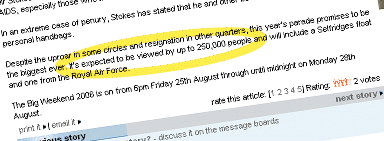
And, on 25 August 2006, in the article ‘We’ll attract record crowds predict Pride festival chiefs,’ The Manchester Evening repeated its exaggerated claim from the previous year. Actually it didn’t just repeat it, it added on an extra 50,000 people. The Evening News quoted a Manchester Pride spokesman who said that ‘about 250,000 people’ had gathered in the city centre to watch the Saturday Parade in 2005 and that this was a figure that the ‘police estimated’ (see update below).
I was at every Pride Parade in Manchester from 1998 to 2005. Some of the reported crowd numbers always seemed extraordinary and I suspected they were an enormous exaggeration. But most of us have no idea what a quarter of a million people standing on the streets actually looks like.
So, last week, I decided to analyse the figures and the Parade route.
Does it matter? Yes. By misleading the public, the current regime can keep control of this event, which makes millions for the city’s businesses and a relatively small, and decreasing, amount for charities.
It’s now clear that the 250,000 figure is untrue and seems to come from the marketing people who control Manchester Pride. Let’s do a few sums and you’ll see why…
On the right you can see my map of the Parade route in 2005. Or you can see a similar map at the Multimap website.
Although the exact route of the Parade has changed a few times over the years, the distance has always remained much the same.
The pink line shows the route taken by the Parade. In 2005, the first crowds were near Victoria Station. The Parade went along Corporation Street, then Cross Street. It turned onto Princess Street, continued along there until a turn into Whitworth Street and on to Fairfield Street. Once it reached Piccadilly Station there were no more crowds.
If you measure the total distance travelled through the city centre on the map, you’ll find that it is about 2,500 yards. Let’s suppose that you can squeeze two people into one yard of kerb.
It would be impossibly tight — I’m not particularly broad, but I measure 18 inches across my shoulders. But suppose it was possible… That would mean approximately 5000 people could stand shoulder-to-shoulder along the entire Parade route on one side of the road. Multiply this by two to get a figure for both sides of the road: 10,000 people.
To get a figure of 250,000 people watching the Parade, the crowd would have to be 25 people deep on each side of the road along the entire route. So, each yard of kerb on both sides of the road would have two people standing shoulder-to shoulder with another 48 people standing behind them.
A crowd that was 25 people deep on each side of the street would take up at least 25 yards of space across the width of the street. It would block the entire width of these relatively narrow city streets, with no room for anything to move along.
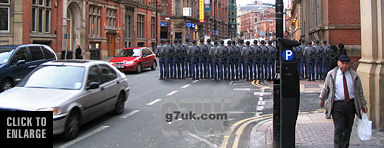
Here, one pedestrian has been ‘Photoshopped’ to give an impression of what a crowd 25 people deep would look like on Princess Street. To get a figure of 250,000 people, there would be 25 on both sides of the road and two rows like this to each yard of kerb space throughout the entire Parade route.
In the real world it would be impossible to pack people like sardines in such huge numbers. Some would die in the crush.
Although the route opens out in one or two places such as Exchange Square, Albert Square and near St Peter’s Square, most of the way the pavement is only about 8ft wide on both sides of the road, with tall buildings behind it.
I measured Princess Street at the point where the photo shown above was taken and it was 17 paces wide from building-to-building. This width is typical of most of the route. I estimate that the street is no more than 45 ft (15 yards) wide from building-to-building.
But don’t take my word on this, you can measure the width of the streets yourself on a satellite image at Google Maps. The scale is at the bottom left of the image
Princess Street next to the Town Hall
Princess Street near China Town
Princess Street near Canal Street.
If the route is 2,500 yards and the road and pavement is approximately 15 yards wide from building to building, that is a total area of 37,000 square yards of road and pavement along the entire route. Suppose you could squeeze four people into every single square yard…
That is 37,000 x 4 = 150,000 people. So, even packing four people into every available square yard of space along the route, you could only fit in 150,000 people.
In fact, in recent years, fences have been put up and numerous security people employed to make sure the public is restricted to the pavement area and does not stand on the road.
As the BBC so wisely put it, the true figure at the Parade is ‘tens of thousands’.
If you look further back, the figures are even more ridiculous. On 29 August 2001, in the article ‘Fury Over Rubbish left by GayFest Revellers’ (see it here), The Manchester Evening News reported that ‘on the Saturday 385,000 people turned out to watch the Parade’.
That would be a crowd 35 people deep on each side of the road, along the entire route. In fact I remember 2001 as being fairly quiet and my photos from that year support this.
Hunting through old documents, I found the ‘Community Report’ that Manchester Mardi Gras published in November 1999. This document was to ‘explain’ their failure to raise any money for charity at all that year. In it, there is this little gem:
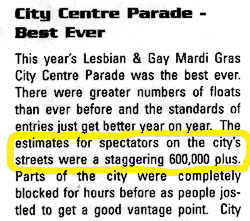
Yes they claimed that 600,000 people watched the parade in 1999. A figure that is more than one quarter of the entire population of Greater Manchester (around 2.2m)! All packed into a couple of streets in Manchester city centre and still with enough room for a parade of floats to move along. What a joke.
These figures in the media probably originate from press releases that are put out by the organisers (since 2003, Manchester Pride has been part of Marketing Manchester — otherwise known as ‘the tourist board’). The information is then regurgitated without much thought by journalists on newspapers and websites.
In this press release, Manchester Pride writes that the 2004 parade was ‘watched by a crowd of over 200,000’.
Perhaps it didn’t matter so much back in 2001 when Manchester’s annual gay event was free to attend. But, now, these phoney figures are being used to encourage the public to buy an entry ticket and travel to Manchester.
Advertisers and sponsors are told that their product will be seen by quarter of a million people at the Parade when, actually, it is less than 50,000 people.
Meanwhile the over-inflated figures, are used to convince the public that Manchester Pride is much more popular than it really is. Other statistics that would be most interesting and no doubt rather embarrassing for the organisers (such as the exact number of tickets sold each year and clear and accurate figures for income and costs) are usually not made public and requests to see this information are ignored.
By doing this, the organisers, marketeers and Manchester City Council look after their big business friends, who make £20m each year from Pride. Misleading numbers can be used to stifle any debate on the future of the event and prevent any discussion on alternatives that could be better, free to enter and which might raise more money for good causes.
Which wouldn’t be difficult when you consider that the £70,000 raised for charity in 2006 was one of the lowest amounts ever.
UPDATE: (12 Feb 2007) Greater Manchester Police has confirmed that it gets estimated attendance figures direct from the organisers. So, when the Manchester Evening News wrote that the ‘police estimated’ a figure of 250,000 in 2005, as mentioned above, actually the Evening News was just repeating the same fake figures from the organisers once again.
Some photographs showing crowds over the years
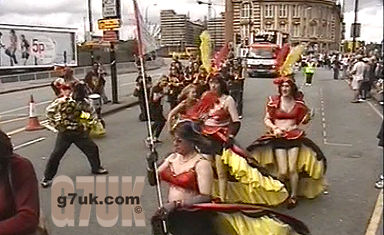
Manchester Pride 2005. As the Parade gets going at the top of Corporation Street near Miller Street, numbers are small and there is no one at all standing on the lefthand side of the road.
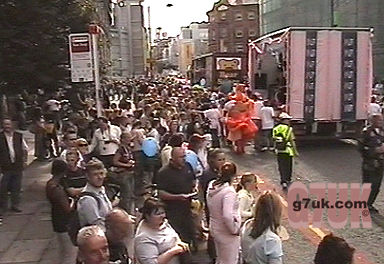
Manchester Pride 2005. Urbis and Exchange Square are some of the busiest spots.
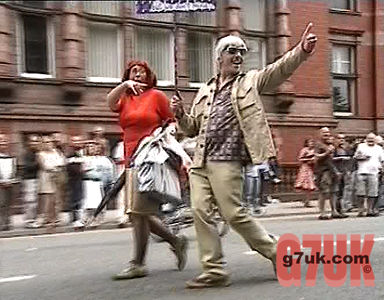
Manchester Pride 2005. At Whitworth Street the crowd is not exactly standing 25 people deep, shoulder-to-shoulder.
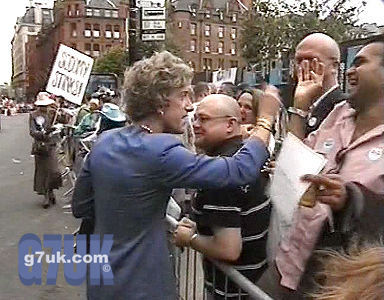
Manchester Pride 2005. Whitworth Street. Note the barriers confining the public to the pavement only.
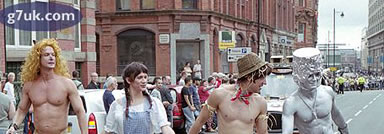
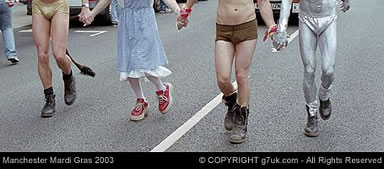
Manchester Mardi Gras 2003. Large gaps in the crowd as the Parade makes its way along Whitworth Street.
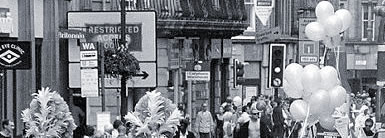

GayFest 2001. The year when supposedly 350,000 people watched the Parade according to The Manchester Evening News. In this picture the Parade is passing along Cross Street which is the heart of the shopping area. Yet you can see that people are able to walk along the half-empty pavement.

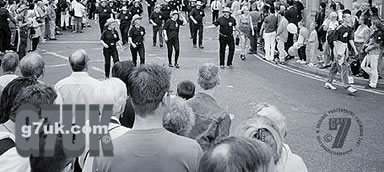
GayFest 2001. The corner of Cross Street and Princess Street. If 350,000 had been watching the Parade, the entire route would have been lined with a continuous crowd that was shoulder-to-shoulder and 35 people deep on each side of the road.
UPDATE (23 Aug 2007): the fraudulent Manchester Pride parade figure is being repeated in publicity from Gaydar Radio about its sponsorship of Manchester Pride:
‘More than 250,000 people are expected to watch the main parade in Manchester on August 25.’
Has Gaydar Radio been deceived by the organisers? Or are they just another branch of the ‘gay mafia’ and a willing partner in this cosy little deception of the general public?
UPDATE (17 Oct 2007)
Hilariously, the 2007 parade route was actually shorter than in recent years. Yet the organisers continue to say that 200,000 or 250,000 people watch the parade.
The 2007 parade started at Beetham tower at the junction of Liverpool Road and Deansgate, followed Deansgate as far as Kendalls department store where it turned into St. Ann Street, then onto Cross Street, along Princess Street, turning into Whitworth Street and finishing at the corner of Whitworth Street and Aytoun Street. A total distance of about 2,270 yards, compared to around 2,500 yards in previous years.
Maps of the parade route: 2006 | 2007.
The official Manchester Pride 2007 map is available here as a PDF.
Measure the width of the road yourself on a satellite image at Google Maps:
The junction of Liverpool Road and Deansgate
The junction of Deansgate and St Ann Street
Princess Street next to the Town Hall
Princess Street near China Town
Princess Street near Canal Street.
News reports that the route is two miles long aren’t true. There are 1,760 yards to a mile. So the 2007 route is only about 1.3 miles.
So, fitting two people to each yard of kerb space, along the entire route would be 2,270 yards x 2 = 4,540 people along one side of the street. Multiply by two to get a figure for both sides of the street. That makes 9,080 people with a crowd one person deep.
To get the 200,000 people that the Manchester Pride Chairman claims watch the parade in this article, the crowd would have to be 22 people deep on both sides of the street. A crowd 44 people wide across the width of the road…
To get 250,000 people, as claimed in a 2007 Manchester Pride press release, the crowd would have to be 27.5 people deep on each side of the street. 55 people across the width of the street.
However, Deansgate, Cross Street, Princess Street and Whitworth Street are only about 15 yards wide from building to building. So these crowd sizes are physically impossible. People would be dying in the crush. Besides which, it would leave no space at all for a parade.
In the same article, the Manchester Pride Chairman claims that ‘100,000 people pass through the event area during the four-day Big Weekend’. How do they do that? When the entire gay village area is fenced off for the entire four days and entry is only possible with a ticket?
The Manchester Pride Chairman is on record as saying that ‘over 40,000 people paid to be part of the celebration in 2005’ and, in the October 2004 issue of outnorthwest magazine, Paul Martin of the Lesbian and Gay Foundation refers to the 36,000 who attended Manchester Pride 2004.
The BBC reports that ‘tens of thousands’ watch the parade and America’s Associated Press says 45,000.
Bearing in mind that many of the people who watch the Saturday parade have also bought a ticket, I suggest that the total number of people who watch the parade and/or buy a ticket is less than 75,000 and may well be under 50,000.
UPDATE (1 July 2008)
The organisers of Manchester Pride have been aware of the calculations above and the physical impossibility of their claims since at least February 2007. However they have continued to mislead the public and advertisers and it is only in the last few weeks, since Trading Standards began looking into the matter, that pages have been edited.
This page has been changed to say ‘in front of thousands of people’. Back in May it claimed that that the parade was:
‘an ideal opportunity to put your business in front of over 250,000 people’.
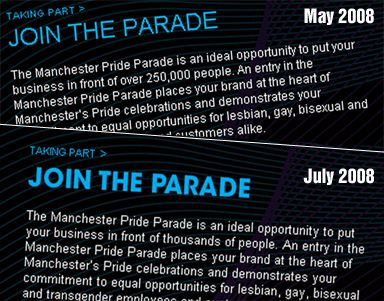
However some pages still haven’t been changed, such as this recent ‘bulletin’ which states:
‘Manchester Pride’s Parade is on Saturday 23 August winding it’s way through the city centre in front of crowds estimated at 250,000 in 2007!’
As mentioned earlier, the term ‘crowd’ can’t possibly include TV viewers. Yet, in the past, the Pride organisers justified their over-inflated figures on the basis that they included people who watched the event on television.
UPDATE (22 August 2008)
Articles are being edited and exaggerated figures removed.
Here’s a six month old archived copy of an article that appeared on Rainbow Network.
In it, the Manchester Pride Chairman (also Chief Executive of Marketing Manchester aka the tourist board) is asked “how many people are you expecting?” and is quoted as saying:
“Pride always attracts a crowd. The parade alone is usually watched by over 200,000 people and 100,000 people pass through the event area during the four-day Big Weekend. ”
Take a look at the current version of the same article. Which has been edited to read:
“Pride always attracts a crowd. The parade alone is very popular and tens of thousands of people pass through the event area during the four-day Big Weekend. ”
However the bulletin page mentioned above still claims that parade crowds were ‘estimated at 250,000 in 2007’.
UPDATE (1 September 2009)
Disappointingly, the BBC News website published a report stating that Pride 2008 had ‘attracted more than 200,000 visitors to the city over the weekend’.
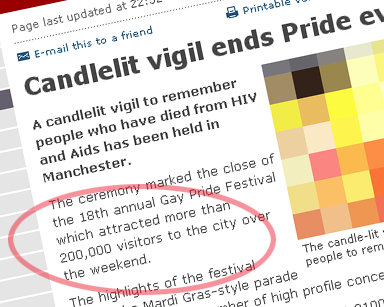
The vastly inflated figure was removed shortly afterwards.
UPDATE (5 February 2009)
The booklet for Liverpool’s Homotopia festival included an article about Merseyside Police. It includes this paragraph about Manchester Pride 2008:
‘This year saw the world’s biggest Police contingent taking part, with over 250,000 people lining the streets’.
You can download a PDF of the booklet here. The quote is on page 16.
The organisers of Homotopia replied to us very promptly. Merseyside Police marketing office had supplied the article they told us. We contacted the Police and asked how they had come to supply such an over-exaggerated crowd figure.
Guess where this trail of evidence leads to? The Police told us that it was their ‘understanding’ that the figures had come from Manchester Pride.
UPDATE (2 April 2009)
Although originally I got the impression that the BBC had been more accurate than most, more recently, examples of the same old exaggeration have come to light. Such as this page from 2004, in which the BBC claims that ‘Manchester’s streets were thronged with up to 250,000 people’.
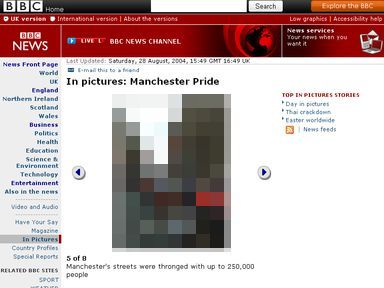



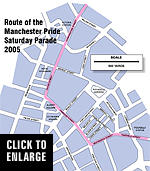
2 Comments
I could only be bothered reading the first two paragraphs of your little rant and already I found flaw. The article stated that 200,000 people “watched” the event. Not attended. Have you ever heard of the media? The article goes on to say that a crowd of 45,000 moved to another place for something else. This tells me that 155,000 people watched this event through some sort of media port, and 45,000 attended. There you go. Mystery explained.
One more point, if you have taken the time to write all this because of something the media said, then you have sadly misconstrued the point of the media. They are there to make everything seem more important than it is. Get over it. They do it about everything, not just Pride.
g7uk.com
in reply to Charlotte:
Thanks for your comment. If you had been able to read a bit further you would have discovered that on 25 August 2006, in the article ‘We’ll attract record crowds predict Pride festival chiefs,’ The Manchester Evening quoted a Manchester Pride spokesman who said:
‘Last year, police estimated that about 250,000 people gathered [my emphasis] in the city centre to watch the main Manchester Pride parade on Saturday.’
And further down it shows a leaflet that was distributed by the organisers in 1999 which states: ‘The estimates for spectators on the city’s streets was a staggering 600,000 plus’.
Obviously people who watch on TV or aren’t otherwise physically there don’t ‘gather’ in the city centre ‘on the streets’.
You’re right, some articles are ambiguous and use the word ‘viewed’. In fact, initially, Manchester Pride tried to justify all the inflated figures by using the excuse that people ‘viewed’ the parade from somewhere else. But there are many other articles, quotes, press releases and web pages out there that clearly state a physical crowd number.
It is physically impossible to fit 200,000 spectators on a parade route that is only about 2,500 yards long and on streets that are only about 15 yards wide in most places measured from building to building. Let alone 600,000 which would be more than quarter of the entire population of the whole of Greater Manchester (population 2.2m).
You can’t expect to have any credibility at all if you post a rant without even looking at the evidence that is immediately in front of you. It isn’t just the media that spreads misinformation. You have done it above and without even reading the article.
It’s especially sad that you seek to justify it on the grounds that everyone is doing it (supposedly). That’s just desperate.